3D Truss Models
-
Nine different truss profiles currently available within the Medeek Truss Plugin:
- Common
- Attic
- Monopitch
- Scissor
- Tail Bearing
- Dual Pitch
- Bowstring
- Bow Barrel
- Floor (System 42)
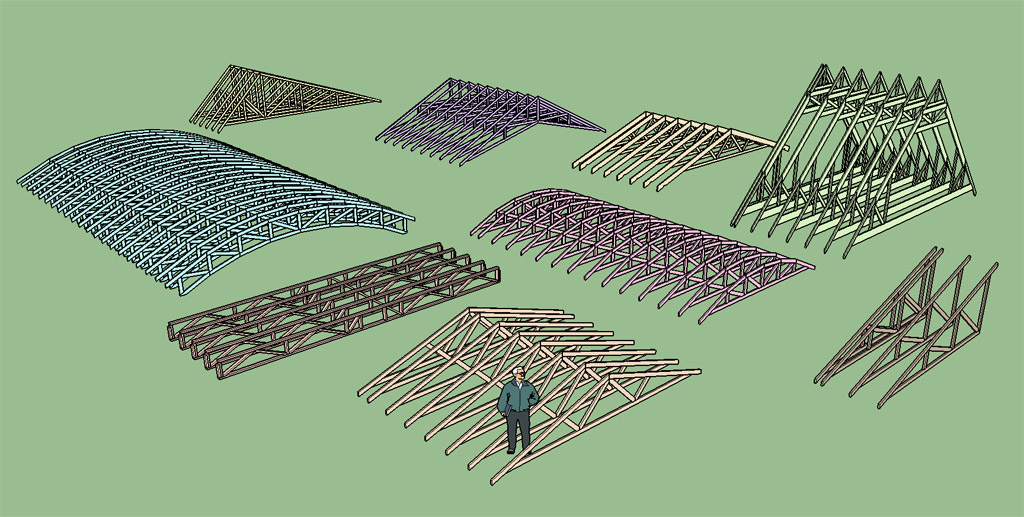
View model here:
3D Warehouse
3D Warehouse is a website of searchable, pre-made 3D models that works seamlessly with SketchUp.
(3dwarehouse.sketchup.com)
Within the common truss family there are currently 11 configurations. The only significant configuration that I am missing is the Mod Fan (Triple Fan).
Are there any truss types I am missing that you would like to see added to the plugin?
-
Are you using a plugin to produce the multi-coloration?
I have a number of items that need addressing as far as the UI goes, it just seems like the list keeps getting longer.
One thing I've decided to add into the advanced options is a soffit cut for the tail of trusses and rafters, this seems to be a common enough request that I should give it some attention.
-
@unknownuser said:
Are you using a plugin to produce the multi-coloration?
Yes of course! As the previous by my hero Chris Fullmer (Random Painter) don't work anymore easilly for me for the last versions of SU i use a marvelous free one by Sdmitch!

(3 choices: Colors Sketchup, Gradiant (2 colors), Palettes-Random yes/not)
In your case all (groups/components) must be exploded to the level 0
Ask it to Sdmitch (it's not published) if you want something specific: Colors inside groups or components maybe!
Here with his tricky DeckBuilder!

(Select any horizontal tortured close surface! )
Et voilà!
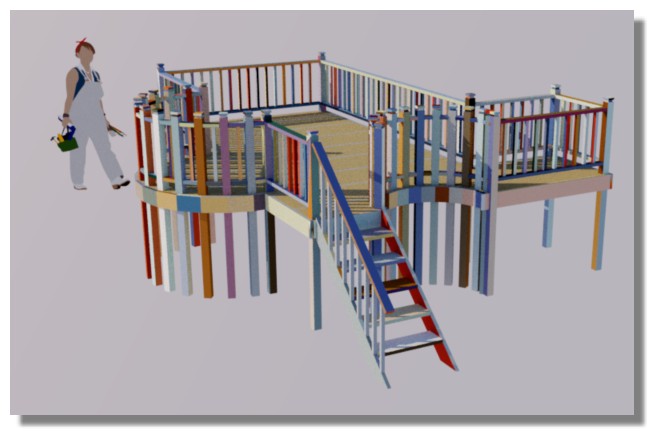
-
Version 1.3.7 - 03.06.2016
- Added Soffit Cut within Advanced Options for common fink truss type.
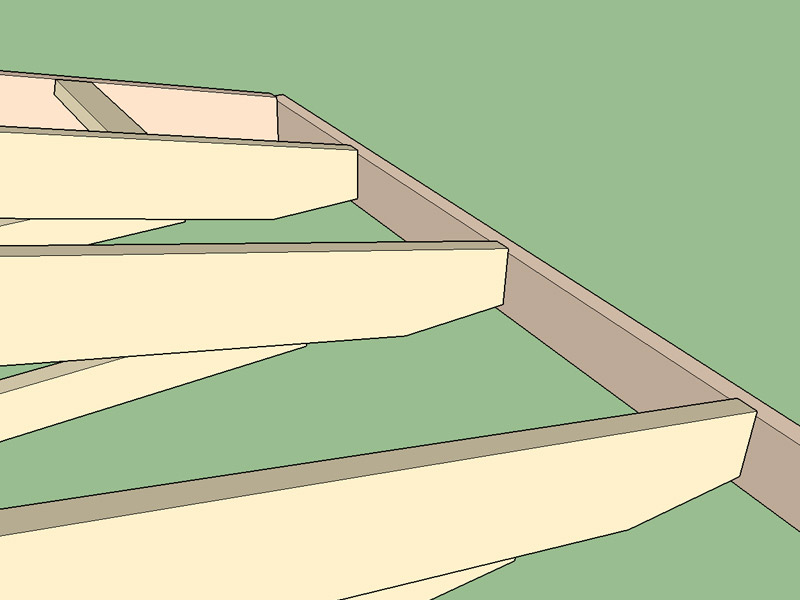
After I'm certain that this feature is robust I will add it to all other truss types and rafter roofs. For now it only applies to roofs that use a common fink truss (non-raised heel).
-
Here is one way to frame an octagonal roof. The basic hip elements were first created with the plugin. This is a study of this type of roof to see what is required to add it into the plugin:

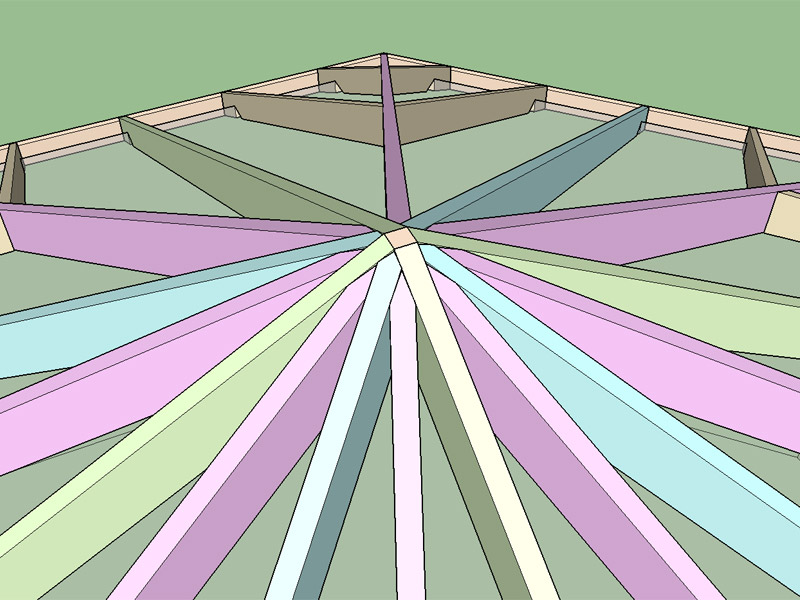
View model here:
3D Warehouse
3D Warehouse is a website of searchable, pre-made 3D models that works seamlessly with SketchUp.
(3dwarehouse.sketchup.com)
Another method would be to use an 8 faceted center block. Dewalt's framing book goes into some alternative methods in some detail. I prefer the method I have shown above because it is much easier to extrapolate the framing method to include elongated octagonal roofs. 8 common rafters and 8 hip rafters come together at the peak, seems like it would be a real pain to try and fasten these at the peak, perhaps someone could enlighten me on how a carpenter would actually put this together.
-
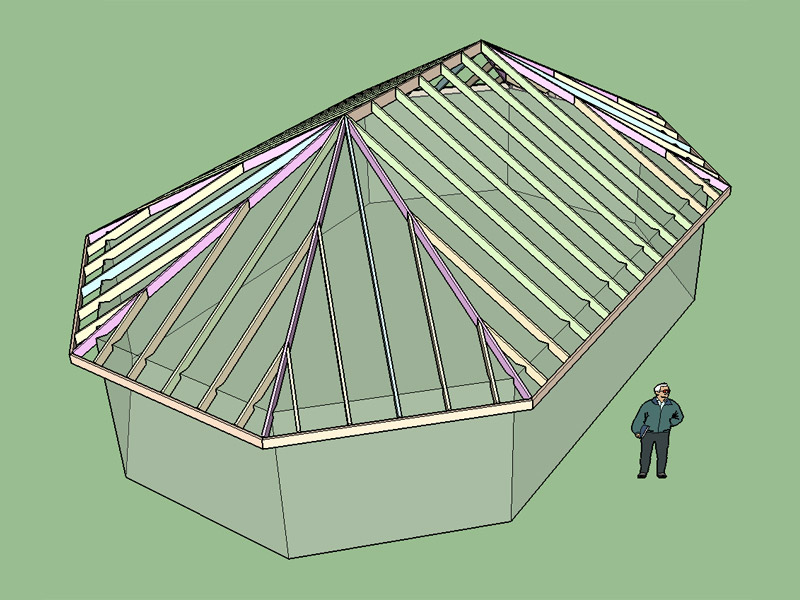
-
Looking at a number of house designs in SketchUp's 3D warehouse its becoming clear to me that most design work is devoid of any of the structural elements (wall framing, roof framing, foundation details etc...) and the primary concern is the layout of the space showing windows and doors. Typically the details are left to the builder or engineer.
I thoroughly enjoy working on this plugin but I'm beginning to doubt that it has any sort of widespread utility. In what circumstances would a house designer feel the need to use this plugin?
-
For presentation purposes no, but many (a smaller number) are using SU for construction drawings.Some builders model the framing beforehand. Many people like the house builder plugin. Some people will like this.
-
I agree that the plugin does have some following but at the same time I should probably try and address things that are more "useful" to the builder, designer or engineer. I am trying to regauge the utility and appeal of the plugin. If I can add features that would attract more users and make it more useful to everyone that would be my ultimate goal.
I'm also considering working on a plugin for residential structural engineering, that would be used for vertical and lateral load analysis of conventional light wood frame structures. I would like to create a product that is comparable to the Woodworks Shearwall program but uses SketchUp as the principle user interface. I think this would prove quite useful to a number of engineers.
I will continue the development of the Truss Plugin but I will limit my time spent on it and only add new features or improvements as direct requests are made by users.
-
@unknownuser said:
In what circumstances would a house designer feel the need to use this plugin?
I believe that a carpenter for industrial or housing project can be interested in a such Truss detailed Plugin!
-
@medeek said:
I've recently added the ability in my online truss calculator to output SketchUp 3D geometry. The generated file uses the plugin method (.rb) where you simply drop the file into your SketchUp plugins folder. The plugin prompts the user for the number of trusses to draw and the truss spacing so that one can create the usual array of trusses for architectural models. For example 4 fink trusses @ 24" o/c would give you something like this:
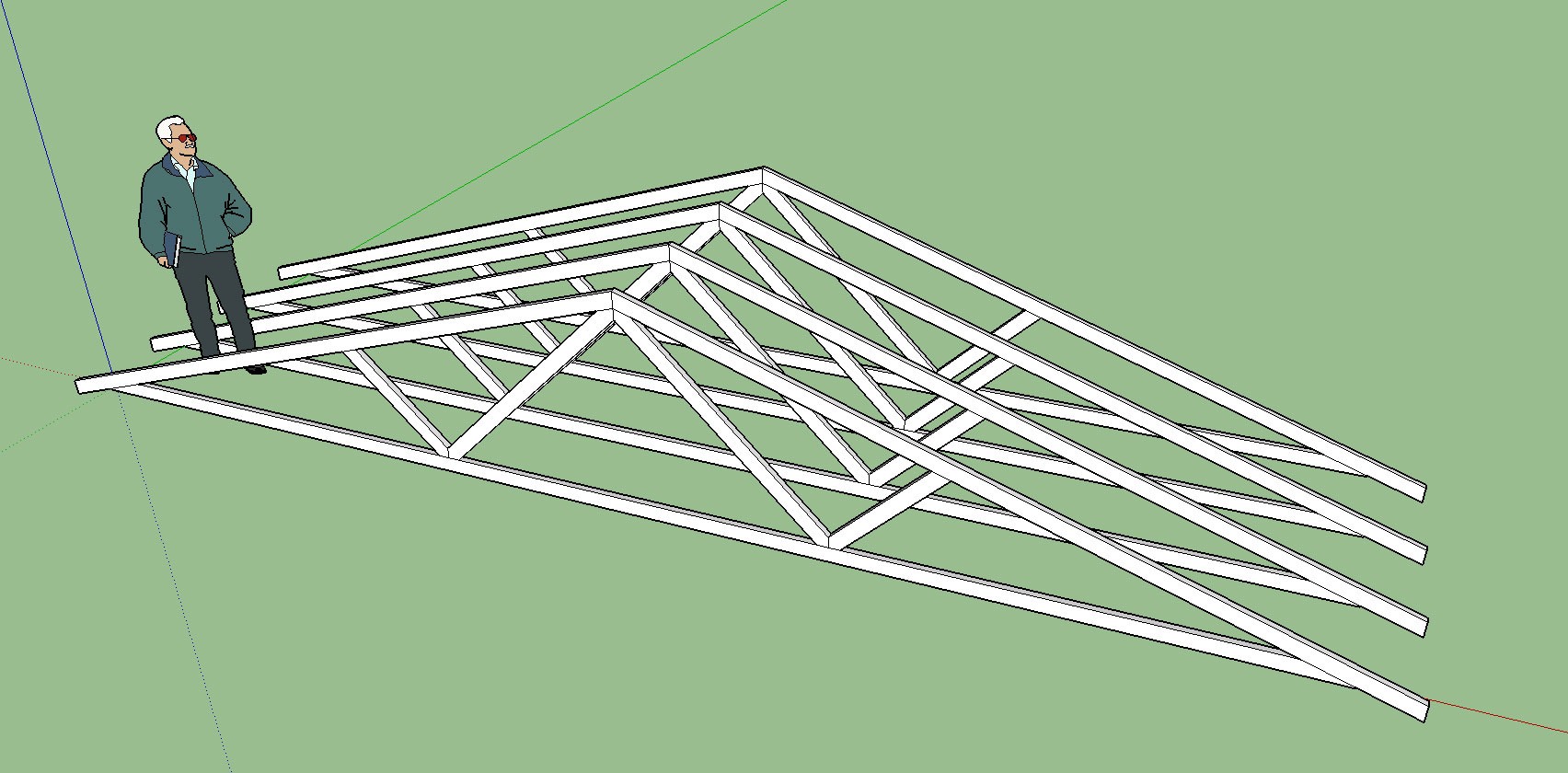
or a single truss might be:
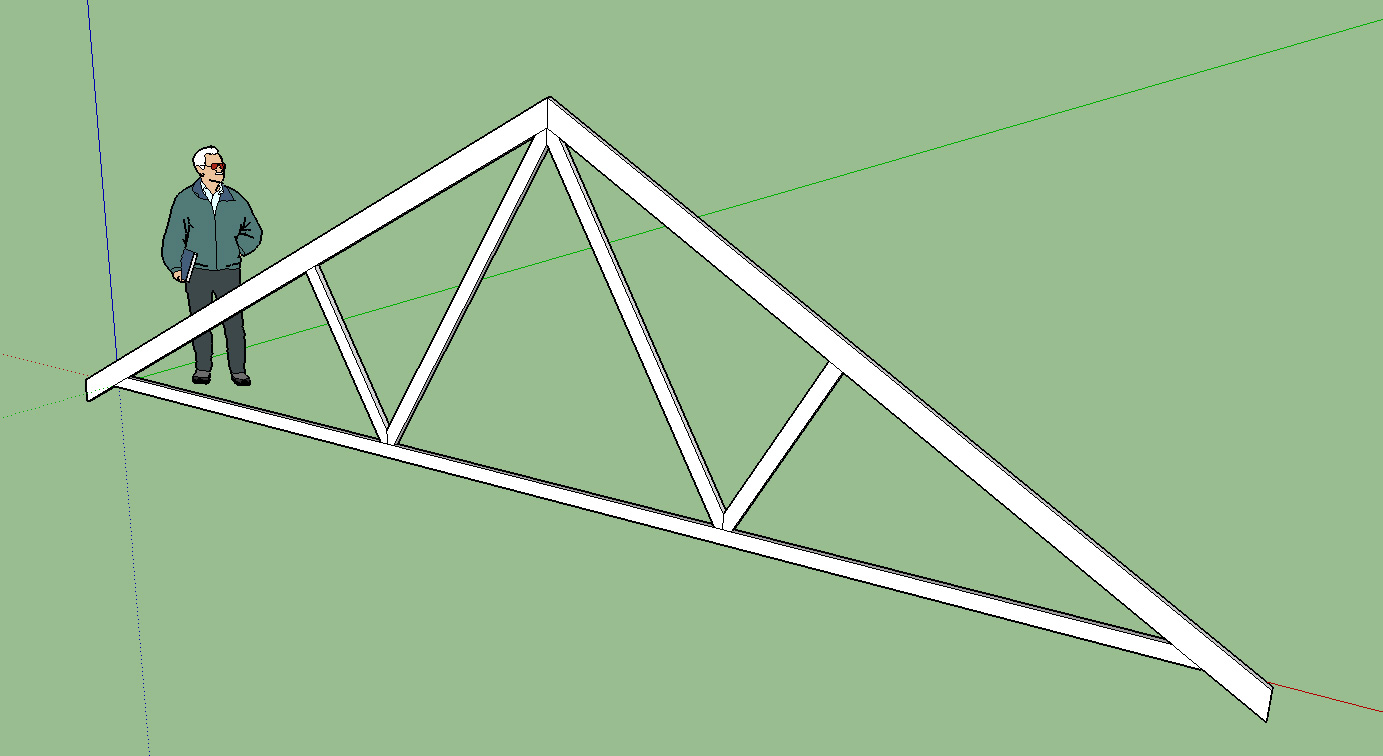
The truss calculator has been around for almost two years but this is the first time I considered providing an output for SketchUp. I'm not a Ruby programmer (perl is my thing) but I found the SketchUp API to be very easy to use and the Ruby programming fairly straight forward and less clunky than even Perl.
Currently only the "fink" truss has the SketchUp output, the truss calculator is located here:
Technically this tool is geared toward the engineer but with the addition of the SketchUp output/functionality it might also be of some use for the DIYer who wants to draw up his/her own design in SketchUp.
Also note that there is a daily limit on the calculator since the server was getting hammered earlier this year and bandwidth became an issue.
==========================
3D Truss - where is its most likely market to the maximum number of users?
That question should be considered in the light of the three stages of design and documentation.
1. Concept Design (the basic or core idea)
This is where SketchUp excels. Layout of 3d spaces (plan in 3d), window and door locations,
orientation of building components in regards solar gain etc.At this stage 3D Truss is more of a distraction than an aid.
2. Design Development(evolving the agreed design with the client, regulations, authorities etc)
This is the stage where construction and materials play a greater role.3D Truss can assist the designer to understand what are the construction issues in regard
details. 3D Truss allows quick studies of roof types, layout etc in regards the required
structure.3. Documentation for Building Permit.
This varies from country to country as to the evolved method of dealing with the structural
computations and granting of a building permit.In Australia the structure design and computations are undertaken by structural engineers,
or companies that use software to verify the structural integrity.The "key factor" is liability for the structure. If the roof blows off who is to be
sued and at what level. In this example the designer and the structural engineer will be
held to account, generally each to a varying percentage.4. Truss Design in other CAD programs.
- Chief Architect focuses on residential design and has a good user base.
Design work flow for complex residential is often:
a. SketchUp - Concept Design, Design Dev (1st stage)
b. Chief Architect - Design Dev (2nd stage - details and materials "locked in")
The above works in a similar way for ArchiCad and Revit.
The "important point" is that SketchUp is the most free flowing and spontaneous of CAD programs.
Now with 2016 and the option of creating IFC (Industry Foundation classes) for components it is easier
to integrate with the two major programs noted above. This mean that initial concept work done in
SketchUp is not lost in the 3D CAD workflow. This is a very import change and should be monitored.
This is why components created in 3D Truss should be classified IFC (simple) at the minimum.
I have attached pdf files from Chief Architects technical help section
https://www.chiefarchitect.com/support/article/You can download a free trial of Chief Architect X8 with use limited for a set time.
5. Surveys to find out what the user wants.
One free survey tool is:
SurveyMonkey: Free online survey software & questionnaire ...https://www.surveymonkey.com/
Create and publish online surveys in minutes, and view results graphically and in real time. SurveyMonkey provides free online questionnaire and survey ..Regards,
Ray
Creating a Vaulted Ceiling and Scissor Trusses.pdf
Creating an Energy Heel Truss.pdf
- Chief Architect focuses on residential design and has a good user base.
-
Based on what you are saying the Design/Development stage is still done largely in Chief Architect, ArchiCAD or Revit. SketchUp is assigned 1st stage only as a quick development tool. This is very similar to my own workflow. I sometimes will use SketchUp to quickly generate a 3D model for the customer but in the end I use AutoCAD to generate all of the construction documents. For me there is a big disconnect between both of these softwares and I end up redrawing everything manually within AutoCAD which is less than desirable.
Given that SketchUp is mostly used for stage 1 development then a detailed framing plugin would not be used at this stage. Basically the other softwares Chief Architect etc... have got this covered.
I appreciate you spelling out the current state of design workflow for a typical designer, this helps put things in more perspective and validates my own concerns and thinking.
I do think a more advanced version of Housebuilder is something I should add as a separate plugin to compliment this plugin. I've actually had a number of requests from people on that.
About 50% of the features of the plugin have been driven by users requests. Feedback has been critical to the development and direction. Please continue to send in requests and I will do my very best to make them a reality.
-
To be clear I am saying there are TWO STAGES in Design Development.
Stage 1 - This is the first look at the issues for discussion with a better understanding of the problem.
As noted SketchUp is the easier tool to use as it allows quick studies in a short
timeframe.Stage 2 - This is undertaken when the "plan" is becoming "locked in" and only minor changes
are expected. At this stage the PRIMARY CAD PROGRAM ( ArchiCad, Revit or other)
are used as prior to SketchUp v16 the 3D model in SketchUp was "dumb" and their was
no link to the PRIMARY PROGRAM.**This has now changed with IFC classifications** (Industry Foundation Classification) of components that can be "read or interpreted by the PRIMARY PROGRAM. As a result the use of IFC will likely extend the use of SketchUp into Design Development Stage 2 **as CAD work done there is not "lost"** For medium to large firms (say 5 people plus) the cost of using a CAD operator on the PRIMARY PROGRAM is higher than using a second level CAD operator using SketchUp. Recent graduates from the schools of architecture are a good example of a second level CAD operator. The cost of SketchUp Pro and plugins is substantially less than a PRIMARY PROGRAM. This would allow say two second level CAD operators to feed a PRIMARY CAD operator. This is all speculative on my part but the driving force is time and money, so it seems likely. Given this evolving change (if it happens?) plugins like 3D Truss will become more useful. Hope this clarifies my previous note. -
One thing is for certain, I really need to incorporate the IFC classifications into the plugin. I've done some reading on the IFC but I'm still as yet a little unclear how to implement it.
At this point the plugin is still in a state of infancy, so it is safe to say it really is hard to gauge how much use or popularity it could have within the design community. I should probably continue to develop it as time allows and perhaps in a year or so I should have a better picture of what sort of following it might have.
I guess the honest question I would like to ask the SketchUp community is: Is this plugin something you need or would like to see?
If the answer is "no", then I have other ideas for plugins that I can divert my attention to.
If the answer is "yes", then I would like to continue developing this plugin and spend as much of my free time as possible to accelerate its development.
Here is the one question survey:

SurveyMonkey 404
Create and publish online surveys in minutes, and view results graphically and in real time. SurveyMonkey provides free online questionnaire and survey software.
(www.surveymonkey.com)
With the results here:
-
Your Survey will get lost in the comments etc. in this current thread.
Can it be entered as a "stand alone" survey as a NEW THREAD ENTRY.Here is an example of what the Survey Question could look like:
Medeek Truss - Survey - please answer one question to assist plugin developer.
Go to survey - https://www.surveymonkey.com/r/59ZSZ8N
Results of survey - https://www.surveymonkey.com/results/SM-TRZQ36SW/
Question:
Is the Medeek Truss plugin something you need or would like to see?
(thread to 3D Truss Models, Medeek Truss plugin - http://sketchucation.com/forums/viewtopic.php?f=323%26amp;t=63133)Your Answer:
Yes or No in survey.
Plugin Developers Comment:
If the answer is "no", then I have other ideas for plugins that I can divert my attention to.If the answer is "yes", then I would like to continue developing this plugin and spend as much of my free time as possible to accelerate its development.
=============================================================================================
Your existing input for a survey follows:
*I guess the honest question I would like to ask the SketchUp community is: Is this plugin something you need or would like to see?
If the answer is "no", then I have other ideas for plugins that I can divert my attention to.
If the answer is "yes", then I would like to continue developing this plugin and spend as much of my free time as possible to accelerate its development.
Here is the one question survey:

SurveyMonkey 404
Create and publish online surveys in minutes, and view results graphically and in real time. SurveyMonkey provides free online questionnaire and survey software.
(www.surveymonkey.com)
With the results here:
-
Nathaniel,
I love your plug-in. However, I did find a restriction which affects what I normally do. I would normally consider the truss overhang to include the sub fascia. So for example, if I had a 24" overhang, the actual length of the truss tail would be 1' 10 1/2". To input the truss overhang, you present a drop down list which doesn't allow me to input this number. I'm not sure why you give a drop down list for this particular value but it would be nice to input a different value. Your use of drop down lists and user inserted values seems entirely appropriate in all the other fields, just not for this one.
KrisM -
@krism said:
Nathaniel,
I love your plug-in. However, I did find a restriction which affects what I normally do. I would normally consider the truss overhang to include the sub fascia. So for example, if I had a 24" overhang, the actual length of the truss tail would be 1' 10 1/2". To input the truss overhang, you present a drop down list which doesn't allow me to input this number. I'm not sure why you give a drop down list for this particular value but it would be nice to input a different value. Your use of drop down lists and user inserted values seems entirely appropriate in all the other fields, just not for this one.
KrisMIn the metric version I have this completely open. I think the original idea was to try and restrict the users to appropriate values for the overhangs. I will look into this and correct it, your right it makes no sense to restrict the values with a drop down list. Thank-you for bringing this to my attention.
-
I've had a user complaint about the high frequency with which I have released updates to the plugin on the SketchUcation website. I will try to combine some of the smaller updates into less frequent larger updates so that the PluginStore does not feel like I am spamming them with updates.
When I make a bug fix or add a new feature I do like to get it out there as soon as possible but perhaps a weekly or bi-weekly updates is more realistic.
Complaint was posted to the YouTube tutorial video here:
-
Version 1.3.8 - 03.10.2016
- Added wireframe (temporary) graphics to the truss positioning tool.
- Added Boise Cascade BCI
 I-joists: 4500, 5000, 6000, 6500, 60, 90.
I-joists: 4500, 5000, 6000, 6500, 60, 90. - Rim joist option enabled for BCI floor joists.
The screenshot above shows the wireframe that is displayed for common truss types.
-
Removed drop down list for all overhang lengths (truss & rafter roofs). Overhangs are now users inserted values.
Advertisement









